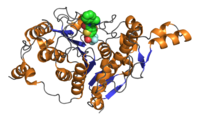
Photo from wikipedia
Abstract Class II histone deacetylases (HDACs) are considered as potential targets to treat Alzheimer’s disease (AD). Previously, C-3 substituted phenothiazine-containing compounds with class II HDAC-inhibiting activities was found to promote… Click to show full abstract
Abstract Class II histone deacetylases (HDACs) are considered as potential targets to treat Alzheimer’s disease (AD). Previously, C-3 substituted phenothiazine-containing compounds with class II HDAC-inhibiting activities was found to promote neurite outgrowth. This study replaced phenothiazine moiety with phenoxazine that contains many C-3 and C-4 substituents. Some resulting compounds bearing the C-4 substituent on a phenoxazine ring displayed potent class II HDAC inhibitory activities. Structure-activity relationship (SAR) of these compounds that inhibited HDAC isoenzymes was disclosed. Molecular modelling analysis demonstrates that the potent activities of C-4 substituted compounds probably arise from π-π stacked interactions between these compounds and class IIa HDAC enzymes. One of these, compound 7d exhibited the most potent class II HDAC inhibition (IC50= 3–870 nM). Notably, it protected neuron cells from H2O2-induced neuron damage at sub-μM concentrations, but with no significant cytotoxicity. These findings show that compound 7d is a lead compound for further development of anti-neurodegenerative agents.
Journal Title: Journal of Enzyme Inhibition and Medicinal Chemistry
Year Published: 2023
Link to full text (if available)
Share on Social Media: Sign Up to like & get
recommendations!